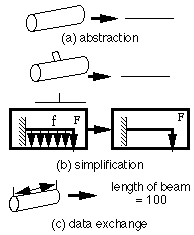The designer select one modeler name from the available modeler list and open aspect modeler.

- Filtering related concepts from metamodel:The pluggable metamodel mechanism find out related concepts from a metamodel. For example, consider the design of a robot arm. If the designer want to evaluate the distortion of arm as a beam model, the pluggable metamodel mechanism collects the concept like, force, entity, connection from a metamodel. In other words, non related concepts like electric flow between motor and battery are filtered out.
- Determine abstraction level for a design object modeler (Figure (a)): The metamodel mechanism determines most appropriate abstraction level for the selected modeler based on the knowledge about design object modeler. The metamodel mechanism suggests concepts included in the determined abstraction level and needed for the selected modeler, and the designer has to give abstract descriptions of the design object using these concepts. In the example of making beam model of arm, the metamodel mechanism suggests to describe the arm only using concepts such as beam, load, support, and bending. Then the designer abstracts the arm concept in the domain of geometry as a beam. This abstraction is computationally done by unification that is an operation to create a new instance that delegates the two concepts of shape ``arm'' and physical feature ``beam.''
- Determine simplification level for the selected modeler (Figure (b)): The designer determines appropriate simplification level for the selected modeler. The designer selects physical phenomena that should be considered in the selected aspect model. In other words, some physical phenomena and some entities might be neglected. For instance, the designer can say that any bending is considered while vibration is not of interest in the arm design.
By selecting open button, the selected plugged modeler opens. After that the designer export information of the metamodel to the plugged modeler by using export menu button. Then data exchange among aspect models are conducted (Figure (c)). Suppose in the example of arm design, a bending aspect model is generated. Since aspect models often require numerical information, the metamodel mechanism requests the designer to specify an appropriate aspect model to feed the required numerical information. For instance, since the generated bending aspect model needs dimensions of the beam, the designer specifies the solid modeler as a source to provide geometric information about the arm. Once this information is given, the metamodel mechanism can maintain consistently the relationship between these two models.
After generating the model, the designer operates the model and generate information about design object. After completing the operation on the model, the designer propagate the result to the pluggable metamodel mechanism.